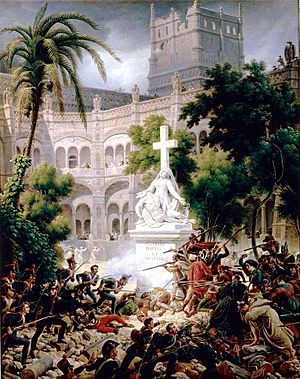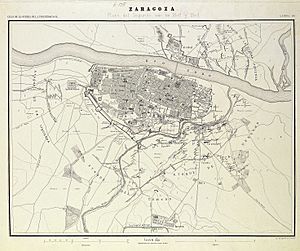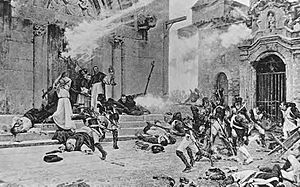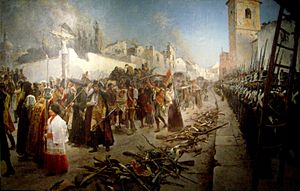Second siege of Zaragoza facts for kids
Quick facts for kids Second siege of Zaragoza |
|||||||
|---|---|---|---|---|---|---|---|
| Part of the Peninsular War | |||||||
 Assaut du monastère de Santa Engracia by Louis-François, Baron Lejeune. Depicts the fighting of February 8, 1809. Oil on canvas. |
|||||||
|
|||||||
| Belligerents | |||||||
|
|
|||||||
| Commanders and leaders | |||||||
| Strength | |||||||
| 50,000 regulars | 30,000 regulars and militia 1,400 cavalry 160 guns 20,000 Spanish civilians |
||||||
| Casualties and losses | |||||||
| 6,000 dead or wounded in combat 6,000 died of disease |
30,000 military 34,000 civilians dead |
||||||
The Second Siege of Zaragoza was a major battle during the Peninsular War in Spain. It happened when French forces attacked the Spanish city of Zaragoza (also spelled Saragossa). This siege was known for its fierce fighting and the incredible bravery of the city's defenders. Even though the French army was much larger, the people of Zaragoza fought hard. A large part of the city was destroyed, and many soldiers and civilians lost their lives.
What Led to the Siege?
The Peninsular War was a big conflict in Europe. It involved France, led by Emperor Napoleon, fighting against Spain, Portugal, and Great Britain.
Why Zaragoza Was Important
Zaragoza had already faced a French attack in 1808, known as the First Siege of Zaragoza. The city successfully defended itself then. This was special because a regular army was defeated by a mix of soldiers and ordinary citizens fighting in the streets.
After this first siege, the French King Joseph Bonaparte, Napoleon's brother, had to pull his troops back. This gave the Spanish a chance to improve their defenses.
Preparing for Battle
The Spanish armies were spread out and didn't have one main leader. Napoleon planned to attack them separately. One important battle was the Battle of Tudela in November 1808. The Spanish armies were defeated there, and many soldiers retreated towards Zaragoza. This set the stage for the second siege.
Building Stronger Defenses
After the first siege, the people of Zaragoza worked hard to make their city stronger. Colonel Sangenís led the effort to build new fortifications.
- South Side: The city used the Huerva River as a natural ditch. They built two strong points, called redoubts, on the other side of the river.
- West Side: A strong wall was built outside the city's old walls. It included convents that were turned into fortresses.
- North Side: Fortifications were added near the Ebro River.
- Key Position: A military camp was built on Monte Torrero, using a canal as a moat.
When the French attack seemed close, 60,000 volunteers helped build these defenses. Inside the city, homes and buildings were connected with secret passages. Each block became like its own small fort. Churches were turned into strongholds for defense.
The city's defenders were also much stronger this time. General Palafox had about 32,000 soldiers and 10,000 armed volunteers. They also had enough food and ammunition for three months.
The French Delay
The Battle of Tudela ended in November 1808, but the French didn't start the siege of Zaragoza until December 20, 1808. This delay was very helpful for the Spanish. It gave them more time to build defenses and gather supplies.
The French army was initially split. One part was sent to prevent other Spanish armies from interfering. This left fewer French soldiers to attack Zaragoza at first. French reinforcements arrived later, bringing their total strength to about 38,000 soldiers and many cannons.
The Siege Begins
On December 20, 1808, the French army arrived at Zaragoza again. They split their forces to attack from different sides.
Phase 1: Attacking the Outer Defenses (December 20, 1808 – January 15, 1809)
The first goal for the French was to capture the Spanish positions on Monte Torrero. On December 21, French cannons began firing. After this, French soldiers attacked and successfully took these positions. This was a big win for the French. It allowed them to set up their main cannons on Monte Torrero, which helped them break through the city's southern wall later.
The French commander, Marshal Moncey, asked the city to surrender on December 22, but the Spanish refused. The French then focused on attacking the Pillar Redoubt and the San Jose convent.
On January 10, 1809, the French began heavily bombarding these positions. The walls of San Jose were soon about to fall. The Spanish tried to counter-attack the French cannons, but they failed. On January 15, Polish soldiers stormed the Pillar Redoubt, which the Spanish had already left.
Phase 2: Breaking Through the Walls (January 16 – January 27, 1809)
By January 16, the main outer defenses of Zaragoza were in French hands. The French could now focus on breaking through the city walls.
From January 17, the French started bombing the city walls from the captured San Jose redoubt. General Palafox knew the walls wouldn't last long. He prepared barricades inside the city, turning it into a confusing maze of small forts.
During this time, the French commander changed to Marshal Jean Lannes. Both sides were also facing problems with sickness. Many soldiers were getting ill.
The French attack on the city walls began on January 24. They captured three crossing points over the Huerva River. The main assault on the city walls started on January 27. French soldiers broke through the walls in three places. They captured a cannon battery and the Santa Engracia convent.
This marked the end of attacking the outer defenses. The next phase would be brutal street fighting.
Phase 3: Fierce Street Fighting (January 28 – February 20, 1809)
The Spanish defenders had been ready for street fighting from the start. Marshal Lannes decided to capture each building and block slowly. He wanted to keep French casualties low.
The fighting in the streets was incredibly fierce. In one convent, French soldiers held one end of a chapel, while Spanish defenders were at the other end. They shot at each other for hours. However, the French had better equipment and training. Thousands of people were dying every day, both from fighting and from disease, which was spreading quickly through the city.
By February, illness was devastating the people of Zaragoza. Only about 8,500 soldiers were left from the original 32,000. Many had died or were sick.
The French didn't know how bad the situation was for the Spanish. French soldiers were also losing morale because the street fighting seemed endless. Lannes ordered another attack on San Lazaro in the north. On February 18, this attack succeeded. Now, the northern part of Zaragoza could also be attacked with cannons.
By February 19, the Spanish defense was failing. General Palafox himself was very sick. He sent a messenger to Lannes to discuss surrendering. He then gave up his command of the army and the city.
The first offer to surrender was rejected, and fighting continued on February 20. However, the city council quickly negotiated to end the battle. The fighting stopped that evening. Most of the city was in ruins. Around 54,000 people had died during the siege.
What Happened Next?
Under the surrender terms, the Spanish soldiers marched out of the city and laid down their weapons. They could choose to become prisoners or join the French army. Only about 8,000 soldiers survived from the 32,000 who started the siege.
The French agreed to respect private property and offered a general pardon to the city. While some looting happened, the city was not completely destroyed by the French.
The suffering in Zaragoza was immense. It's estimated that 54,000 people died, including 20,000 soldiers and 34,000 civilians. The city, once called the "Florence of Spain," was largely destroyed. Many important buildings were lost.
The French also suffered heavy losses, with about 10,000 soldiers dying from battle or sickness. General Palafox was taken prisoner by the French.
See also
 In Spanish: Sitio de Zaragoza (1809) para niños
In Spanish: Sitio de Zaragoza (1809) para niños
|




